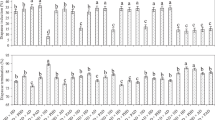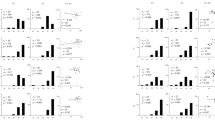Abstract
Diapause in the pink bollworm, Pectinophora gossypiella, is a quantitative genetic character that is in turn regulated by external environmental factors. A naturally occurring non-diapause strain of the insect from south India and two diapause strains from Arizona (U.S.A.) were used in crosses to study the inheritance of diapause. The F1 progeny expressed a diapause response intermediate between the two parents and no clear dominance was evident for the non-diapause character. It was not possible to classify the phenotypes of backcross and F2 progeny in accordance with simple Mendelian ratios. Comparisons of reciprocal crosses indicated that the progeny from male parents of the Indian strain usually had a lesser incidence of diapause. Such sex related differences were more evident in F2 progeny and backcrosses. It is therefore concluded that diapause in the pink bollworm is inherited in a complex way and that non-diapause is not completely dominant over the diapause trait. The study also indicated that incomplete dominance for non-diapause involves a sex-linked gene.
Similar content being viewed by others
References
Ankersmit G. W. and Adkisson P. L. (1967) Photoperiodic responses of certain geographical strains of Pectinophora gossypiella (Lepidoptera). J. Insect Physiol. 13, 553–564.
Barry D. and Adkisson P. L. (1966) Certain aspects of genetic factors involved in the control of larval diapause of the pink bollworm. Ann. entomol. Soc. Am. 59, 122–125.
Bell R. A. and Joachim F. G. (1977) Techniques for rearing laboratory colonies of tobacco hornworms and pink bollworms. Ann. entomol. Soc. Am. 69, 365–373.
Crow J. F. (1957) Genetics of insect resistance to chemicals A. Rev. Ent. 2, 227–246.
Danilevskii A. S. (1965) Photoperiodism and Seasonal Development of Insects. Oliver & Boyd, London.
Hoy M. A. (1978) Variability in diapause attributes of insects and mites: some evolutionary and practical implications. In Evolution of Insect Migration and Diapause (Ed. by Dingle H.), pp. 101–126. Springer, New York.
Klassen W., Knipling E. F. and Mcguire J. U. (1970) The potential for insect-population suppression by dominant conditional lethal traits. Ann. entomol. Soc. Am. 63, 238–255.
Kryson J. L. and Branson T. F. (1977) Inheritance of diapause intensity in Diabrotica virgifera. J. Heredity 68, 415–417.
Lakovaara S., Saura A., Santibanez S. K. and Ehrman L. (1972) Aspects of diapause and its genetics in northern drosophilids. Hereditas 70, 89–96.
Lees A. D. (1955) The Physiology of Diapause in Arthropods. Cambridge University Press, London.
MacFarlane J. R. and Drummond F. H. (1970) Embryonic diapause in a hybrid between two Australian species of field cricket, Teleogryllus (Orthoptera: Gryllidae). Aust. J. Zool. 18, 265–272.
Masaki S. (1961) Geographic variation of diapause in insects. Bull. Fac. Agric. Hirosaki Univ. 7, 66–98.
Nagatomo T. (1953) Genetic studies on the voltinism in the silkworm. (In Japanese.) Bull. Fac. Agric. Kagoshima Univ. 2, 1–70.
Ohmachi F. and Masaki S. (1964) Intercrossing and development of hybrids between the Japanese species of Teleogryllus (Orthoptera: Gryllidae). Evolutio. 18, 405–416.
Pearson E. O. (1958) The Insect Pests of Cotton in Tropical Africa. Empire Cotton Growing Corp. and Commonwealth Institute of Entomology, London, pp. 164–200.
Rabb R, L. (1969) Diapause characteristics of two geographical strains of the tobacco hornworm and their reciprocal crosses. Ann. entomol. Soc. Am. 62, 1252–1256.
Raina A. K. and Bell R. A. (1974a) Influence of dryness of the larval diet and parental age on diapause in the pink bollworm Pectinophora gossypiella (Saunders). Environ. Entomol. 3, 316–318.
Raina A. K. and Bell R. A. (1974b) A non-diapausing strain of pink bollworm from southern India. Ann. entomol. Soc. Am. 67, 685–686.
Sparks A. N., Brindley T. A. and Penny N. D. (1966) Laboratory and field studies of F1 progeny from reciprocal matings of biotypes of the European corn borer. J. Econ. Entomol. 59, 915–921.
Tauber M. J. and Tauber C. A. (1979) Inheritance of photoperiodic responses controlling diapause. Bull, entomol. Soc. Am. 25, 125–128.
Author information
Authors and Affiliations
Rights and permissions
About this article
Cite this article
Raina, A.K., Bell, R.A. & Klassen, W. Diapause in the Pink Bollworm: Preliminary Genetic Analysis. Int J Trop Insect Sci 1, 231–235 (1981). https://doi.org/10.1017/S1742758400000461
Received:
Revised:
Published:
Issue Date:
DOI: https://doi.org/10.1017/S1742758400000461




